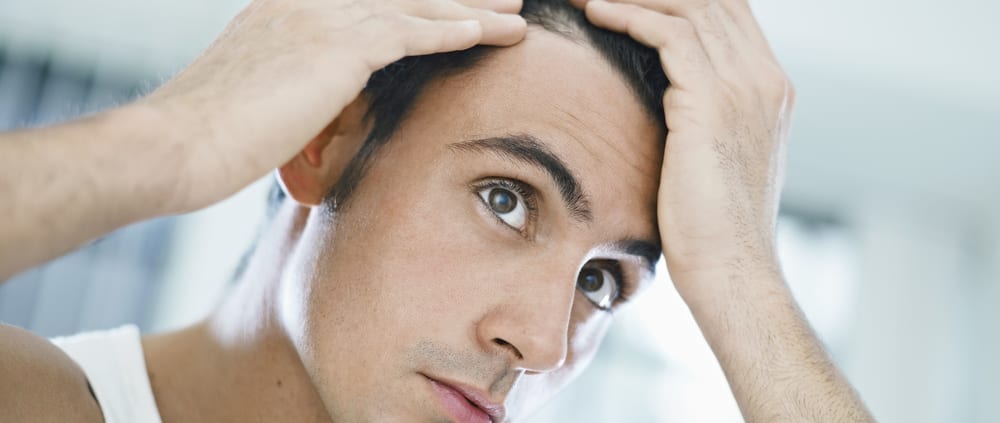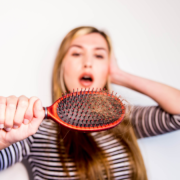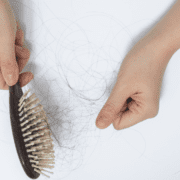Treatment for Androgenetic Alopecia in Men and Women
By Kyleen Davis, FNP
Androgenetic alopecia (AGA) is the medical term used to describe a type of hormone-related hair loss that occurs in genetically-susceptible men and women. It is extremely common, affecting approximately 50 million men and 30 million women in the United States. Androgenetic alopecia can be significantly distressing to affected individuals and seriously impact their quality of life. Fortunately, multiple treatment strategies have been shown to help.
The onset of AGA is typically between the ages of 20 to 40 years old, but can start as early as a person’s teens. The risk of developing this condition increases later in life. Men are more commonly affected than women and may present in different ways. In males, recession of the frontal hairline is noted early on, followed by a gradual thinning at the temples and crown, forming an “M” shape. In females, the frontal hairline is preserved with a generalized thinning of the hair and widening of the part. AGA rarely leads to complete baldness in women. Other common features of AGA include gradual onset of hair loss, increased hair shedding, and a transition from large, thick, pigmented hairs to thin, short, wispy hairs.
Diagnosing Androgenetic Alopecia
Patients with suspected AGA should be evaluated by an experienced dermatologic provider. A careful medical history and physical examination of the hair, scalp, and nails should be obtained, along with laboratory testing to rule out underlying diseases or vitamin deficiencies. A biopsy of the scalp is occasionally necessary to differentiate AGA from other types of alopecia.
Treatment of Androgenetic Alopecia
Once a diagnosis of AGA is established, treatment may be initiated with one of the following medications:
- Minoxidil:
- Available in 2% or 5%, topical minoxidil is the most commonly recommended treatment for AGA. Patients need to use this medication continuously for one year before determining if it will work for them. At the beginning of treatment, individuals may notice a temporary increase in hair loss, which stops as the hair begins to regrow. Common side effects include dryness, scaling, and/or itching of the scalp. Occasionally, excessive hair growth in unwanted places, like the cheeks or forehead, may occur as a result of taking this medication.
- Prescription medications:
- Finasteride is an FDA-approved medication used to treat AGA in men. It has been shown to halt the progression of hair loss while also leading to regrowth of hair in many cases. A commonly reported side effect is sexual dysfunction, which is reversible once the medication is stopped.
- Spironolactone is often used in women with female-pattern hair loss. This medication acts to suppress the effects of certain hormones, and can be particularly useful in polycystic ovarian syndrome (PCOS) and hirsutism—defined as excessive hair growth on the body.
- Vitamins:
- Many supplements containing biotin, folic acid, and antioxidants have helped patients with thinning hair. It is important to mention any supplements you are taking to your physician prior to laboratory testing as they may affect results.
- Shampoos:
- One prescription shampoo, ketoconazole, has been shown to increase hair thickness in several studies. In addition, other over-the-counter shampoos can help hair hold moisture, making it appear thicker and fuller, as well as reduce breakage.
- Laser therapy:
- The FDA has approved low-level laser devices to treat hair loss at home. These lasers emit a low level of light that has been shown to help grow hair in a limited number of studies.
- Platelet-rich plasma therapy:
- Platelet-rich plasma therapy (PRP) uses a person’s own blood to stimulate cells to grow hair. After the blood is drawn, it is spun down in a machine, separating it into different components. The plasma is then injected into the scalp. PRP therapy is a relatively new therapy with studies currently underway to help determine its safety and efficacy.
If you suspect you have AGA, it is important you see your dermatologist as soon as possible to discuss the treatment options that are best for you. Treatment works best when started at the first sign of hair loss.
Shop hair care products now on our online shop.
References:
- American Academy of Dermatology. Thinning hair and hair loss: could it be female pattern hair loss? Available at: https://www.aad.org/public/diseases/hair-loss/types/female-pattern. Accessed May 23, 2020.
- Feinstein, R. (2020). Androgenetic alopecia. Medscape. Available online at: https://emedicine.medscape.com/article/1070167-overview#a4. Accessed May 23, 2020.
- Harvard Women’s Health Watch. (November 2018). Treating female pattern hair loss. Harvard Health Publishing: Harvard Medical School. Available online at: https://www.health.harvard.edu/staying-healthy/treating-female-pattern-hair-loss. Accessed May 23, 2020.
- Gan, D. & Sinclair, R. (2005). Prevalence of male and female pattern hair loss in Maryborough. Journal of Investigative Dermatology Symposium Proceedings, 10, 184-189.











